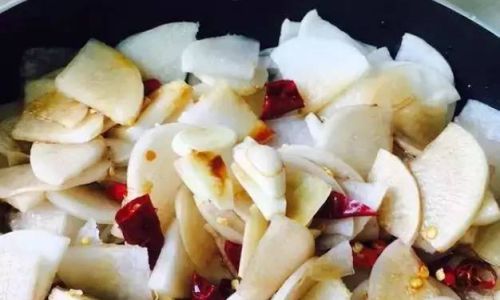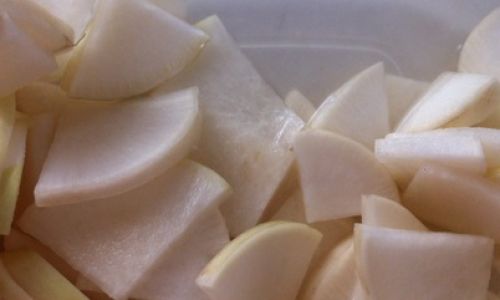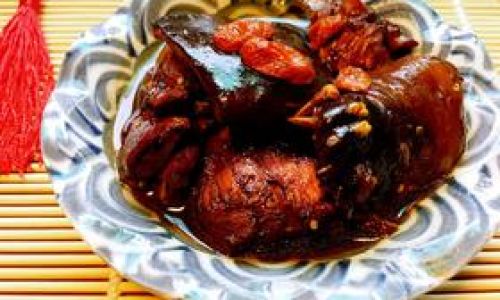Table of content
Pickling vegetables is a timeless culinary tradition that preserves the freshness and enhances the flavor of produce through a combination of brines, spices, and fermentation. Among the myriad of vegetables that lend themselves well to this preservation technique, daikon radish (Raphanus sativus var. longissimus), also known as white radish or mooli in some regions, stands out due to its crisp texture and mild, slightly sweet taste that can absorb and complement a wide range of flavors. In this article, we will delve into the intricacies of how to pickle daikon radish to achieve the most delightful and appetizing results, ensuring that every bite brings a burst of flavors to your palate.

Understanding Daikon Radish
Before diving into the pickling process, it’s crucial to understand the unique characteristics of daikon radish. This long, cylindrical root vegetable boasts a high water content and a mild, slightly spicy flavor profile when raw. Its texture remains crisp even after cooking, making it an ideal candidate for pickling. Daikon’s ability to absorb flavors makes it particularly suited for various pickling methods, whether it’s quick refrigerator pickles, fermented pickles, or those that involve longer brining periods.
Selecting the Perfect Daikon Radish
The first step in creating delicious pickled daikon is selecting high-quality, fresh radishes. Look for firm, smooth, and unblemished daikon with a bright white or light green exterior. Avoid those with soft spots, cracks, or discoloration as they may indicate spoilage or a loss of freshness. The freshness of the daikon will greatly impact the final taste and texture of your pickles.
Preparation Techniques
-
Cleaning and Peeling: Begin by thoroughly washing the daikon under running water to remove any dirt or residue. Peel the outer layer using a vegetable peeler if it’s thick or has imperfections. For a more rustic, earthy flavor, some recipes call for leaving a thin layer of skin on.
-
Slicing and Shaping: The shape and thickness of your daikon slices will affect both the pickling time and the final texture. For quick pickles, thin rounds or matchsticks work best as they absorb flavors quickly. For longer fermentation processes, you might opt for thicker slices or even whole, peeled daikon that retains its shape better over time.
Pickling Methods
Quick Refrigerator Pickles
This method is perfect for those who want to enjoy pickled daikon immediately or within a few days. It involves using a vinegar-based brine that quickly infuses the radish with flavor and preserves it without the need for fermentation.
Ingredients:

- 1 large daikon radish, sliced or cut into desired shape
- 1 cup distilled white vinegar
- 1 cup water
- 2-3 tablespoons sugar (optional, for balance)
- 1-2 teaspoons salt
- Spices and herbs (such as garlic cloves, red pepper flakes, dill, or mustard seeds) to taste
Instructions:
- In a saucepan, combine vinegar, water, sugar, and salt. Heat until the sugar and salt are fully dissolved.
- Add your chosen spices and herbs to the brine and let it simmer for a few minutes to release their flavors.
- Remove from heat and let the brine cool completely.
- Pack the daikon slices into a clean, glass jar, ensuring they are submerged. Pour the cooled brine over the daikon, ensuring all pieces are fully covered.
- Secure the lid and refrigerate for at least 24 hours before enjoying. The pickles will continue to develop flavor over the next few days.
Fermented Pickles
For a more traditional, probiotic-rich pickle, fermentation is the way to go. This process involves using naturally occurring bacteria on the surface of the daikon to create lactic acid, which preserves the vegetable and adds a tangy, sour flavor.
Ingredients:
- 1 large daikon radish, sliced or cut into desired shape
- 2-3% brine solution (for every 1 liter of water, add 20-30 grams of salt)
- Optional flavorings: whey, a piece of previously fermented vegetable (starter culture), garlic cloves, ginger slices, or chili peppers
Instructions:
- Prepare the brine by dissolving the salt in water. Ensure the salt is fully dissolved and let it cool to room temperature.
- Pack the daikon slices into a clean, non-reactive fermentation vessel (such as a glass jar). Add any optional flavorings.
- Pour the cooled brine over the daikon, ensuring all pieces are submerged. Use a weight (like a smaller jar filled with water) to keep the daikon submerged under the brine.
- Cover the jar with a loose-fitting lid to allow gases to escape while preventing contaminants from entering.
- Place the jar in a cool, dark place. Fermentation can take anywhere from 3-10 days, depending on taste preference and ambient temperature. Start tasting after 3 days and continue until you reach the desired level of tanginess.
- Once fermented to your liking, refrigerate to slow down further fermentation and preserve the pickles.
Storage and Serving Tips
- Storage: Always store pickled daikon in an airtight container in the refrigerator. Quick refrigerator pickles can last up to a month, while fermented pickles can be enjoyed for several months if properly stored.
- Serving: Pickled daikon pairs beautifully with a variety of dishes. Use it as a side to grilled meats, add it to salads for crunch, or enjoy it straight out of the jar as a snack. Its versatility makes it a welcome addition to any meal.
Conclusion
Pickling daikon radish is not only a way to preserve this versatile vegetable but also to elevate its flavor profile in countless culinary applications. Whether you prefer the quick satisfaction of refrigerator pickles or the probiotic benefits of fermented pickles, the key to success lies in careful selection, proper preparation, and patience. By following these guidelines, you’ll be able to create pickled daikon that is not only delicious but also bursting with the fresh, vibrant flavors that make this vegetable a culinary treasure. Happy pickling!






0 comments